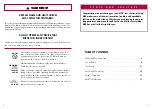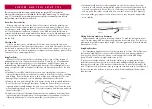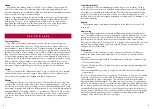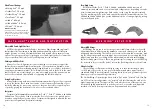
10
11
At MSR, we’ve been wind testing our tents since 1973. Of course back then we didn’t
have access to a wind tunnel, so we simply set up our tents on the back of a flatbed
truck and hit the highway. Today, in addition to countless hours of field testing, we utilize
the University of Washington’s wind tunnel, as well as our own in-house computerized
stress-testing, cold-weather chamber, UV-tester, and tear-strength testers to make sure
that our tents will stand up to the rigors of backcountry use.
Wind Tunnel vs. Real World
There are many factors that influence field performance of tents as compared to
performance in a wind tunnel. Nevertheless, wind-tunnel testing is valuable both for
comparisons and absolute measures of performance. The obvious factors influencing
real-world performance but not present in a wind tunnel may include:
• Turbulence: More turbulence will be a result of ground-surface roughness and local
vegetation, and can create slightly higher forces on the tent.
• Gustiness: This is a major factor that may result in earlier collapse, increased stress
on seams and attachment points, increased bending loads, etc. as compared to a
steady wind velocity.
• Environment friction effects: Any roughness in the terrain, vegetation (even if just
sparse grass), or being downwind of an upslope in terrain will greatly decrease
the applied wind load. Tents typically present the largest horizontal exposure at
ground level, so wind-tunnel loads are a worst-case scenario in this respect.
• Changing impingement angles: The University of Washington Kirsten Wind Tunnel,
because of its size, generally allows testing only with the smallest tent cross section
into the wind. Obviously higher loads on the tent will be encountered with different
exposures. Failure modes will likely be different as well, depending on the pole
configuration and presence of guylines. No effect is expected due to dynamically
changing impingement angles.
• Tent contents: A tent with people and gear inside will have the floor restrained
over a much larger area than occurs in the wind tunnel with a “body” in the tent.
The field condition should reduce airflow under the tent and perhaps give partial
support to the tent walls.
• Air density: Altitude effects, and to a lesser extent temperature effects, on air
density are not present in the wind tunnel. For example, at 15,000’ elevation, the
air density is one half that of sea level, so the wind load would also be reduced by
half at the same velocity.
• Flatness of tent site: A field tent site may not be as flat as the wind tunnel or may
not have ideal guy-out locations. Both of these could result in a less taut pitch,
which could reduce the tent performance.
T E N T T E S T I N G
Figure 3
ALUMINUM SLEEVE
SPLINTERED FERRULE
Slide over break
Zippers
Environments where sand and grit get in the zipper teeth can cause abrasion
and damage to your zipper sliders. If you use your shelter in these conditions, keep
the zipper teeth clean by rinsing them out with water. The pressure from a regular
garden hose will push out small sand particles from inside the zipper coil. Handling
your zipper slider with care can also prolong the life of the zipper. Just like a zipper
on a duffle bag or piece of luggage, align the tracks before sliding the zipper. If
you do not camp in the type of conditions described above, your zippers should last
indefinitely.
Fabric & MicroMesh
™
Tears
Unfortunately, sometimes damage does occur to your shelter. You can do minor
repairs in the field using one of several options. MSR
®
offers waterproof, self-adhesive
patches
(sold separately)
for all the fabrics and MicroMesh
™
on your shelter. Seam
sealers are also a good option for small holes, and duct tape can be used for minor,
temporary field repairs. If you use duct tape, be sure to remove it as soon as you are
through with your trip. Otherwise, the adhesive will eventually eat away at the fabric
and you will end up needing a larger patch. We recommend carrying at least one
emergency repair item as a precaution. If you have a large tear, the MSR Product
Service Center can also fix your shelter after you return from your trip.
Pole Repairs
If a tent pole breaks, you can make a temporary splint with the pole-repair sleeve.
Slide the repair sleeve over the broken section (see Figure 3) and tape or wedge it in
place to hold it secure.
Fire
Our shelters meet the strict fire-resistant standards set for every state in the U.S.
and Canada. But, shelter fabrics are flame-retardant, not fireproof. Shelter material
will melt if exposed to open flame or high heat. Never use fueled appliances or
flame-producing items of any kind inside your tent. Position your shelter away from
camp stoves, campfires, or other flame-producing items.









